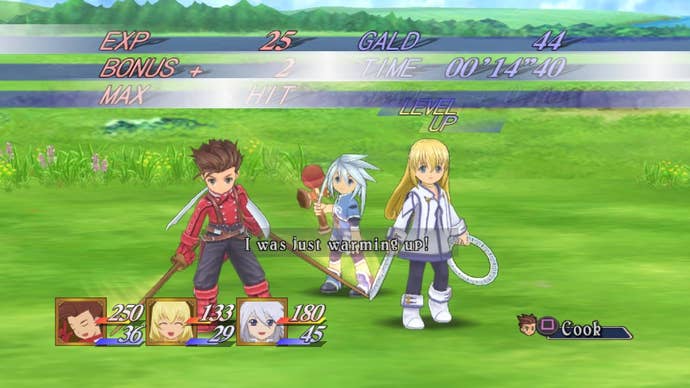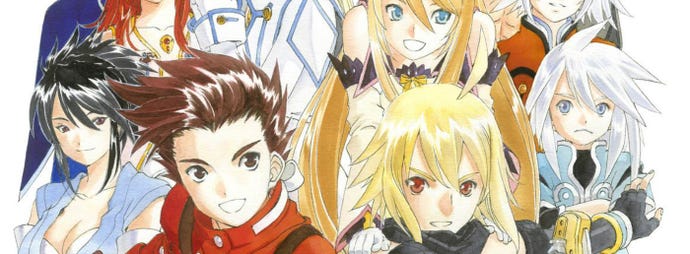Tales of Symphonia Chronicles PS3 Review
Namco brings us the best of Tales and the worst of Tales in one economy-size package.
This article first appeared on USgamer, a partner publication of VG247. Some content, such as this article, has been migrated to VG247 for posterity after USgamer's closure - but it has not been edited or further vetted by the VG247 team.
In this time of mass hysteria over new consoles, RPG lovers know it's better to be stuck in the past. Arriving barely a month before Square-Enix's Final Fantasy X/X-2 HD Remaster, Namco's Tales of Symphonia Chronicles offers a nearly identical proposition: two sizable last-gen RPGs-or maybe that should be "last-last-gen"-on a single disc. And, like Final Fantasy, this Tales compilation pairs one original work with what could fairly be called a "cash-in-" though Final Fantasy X-2 at least has the distinction of being polarizing when compared to Tales of Symphonia: Dawn of the New World's relative obscurity.
Tales of Symphonia definitely stands as the star attraction in Chronicles; with its status as both the first fully polygonal Tales game and a (limited) GameCube exclusive, Symphonia feels like it has something to prove. Of course, technical competency from 2004 doesn't exactly hold up ten years later, but just as Tales of Destiny tries to capture the feeling of 16-bit level-grinding, Symphonia takes the form of a throwback to the following console generation, when Japanese-developed RPGs were at their most ambitious. As the genre scaled back drastically to save itself, Symphonia aspired to be just as big and meaty as the many PlayStation RPGs developed in the wake of Final Fantasy VII's success-one of the main reasons why this Tales kept my attention more than any other released since.

Symphonia definitely suffers from the problems series veterans would expect from a Tales of Game: cardboard characters, neologism abuse, and an overall tinge of blandness. Despite these problems, Symphonia's battle system outweighs Tales' inherent faults just for being so snappy and addictive. The Tales series as a whole set out to make random encounters in RPGs involve more than just the brainless mashing of a single button, and Symphonia's are the logical conclusion to this mission statement. Unlike the later games, combat is still essentially in 2D, but since Symphonia grants rewards for finishing a battle as fast as possible, there's an emphasis on speed that does a fantastic job of cutting down on the tedium of fighting the same grouping of enemies for the dozenth time. And though Symphonia is a story-heavy RPG, this focus on pacing pervades the entire production; load times are practically imperceptible, and story segments fly by as fast as you can read them.
Make no mistake, Tales of Symphonia is huge; the game deceptively telegraphs its length, so just as you think you might have reached the end, you're proven drastically wrong-I know my original GameCube save clocks in at 100-plus hours. And there's a lot to play with within its deceptively simple confines, like a flexible ability system that progressively unlocks new attacks based on the ones you use in battle, and programmable AI commands to keep your computer-controlled party members from being not-so-stupid. If you somehow missed Symphonia thanks to its original GameCube-only release and you're looking for an RPG that feels like a souped-up version of your 32-bit favorites, this Tales installment along makes Chronicles worth the price of admission-even if there's very little remastering to speak of.
Tales of Symphonia: Dawn of the New World, on the other hand, comes off as entirely inessential, and eerily similar to Final Fantasy XIII-2, another disposable follow-up. DotNW picks up after the events of Symphonia, which cast the protagonist of the previous game in a much more antagonistic light. The game doesn't do anything particularly clever with this role reversal, though, and instead makes players suffer by making them take the role of one of the most pathetic main characters ever seen in an RPG. Their intent to have you see this character mature over time is apparent, but he spends so much time questioning himself that it's easy to see DotNW as a moralistic tale about the wonders of self-esteem, aimed at an audience that isn't known for making eye contact.

Dawn of the New World also gets off on the wrong foot with an extraordinarily poorly-paced beginning that only starts to dissipate within the first half-dozen hours. And after that, there's a sense that the lack of any real story to tell requires some serious padding to beef this game up to standard RPG length, which means you'll be visiting old areas all over again under the thinnest of pretenses. The main draw of Symphonia-its speedy, responsive battle system-has also been changed for the worse in DoTNW, giving it a sluggish, unfriendly feeling that ends up making enemy encounters much more frustrating than they should be (and it's only made worse when you play the two games back-to-back). To be fair, DotNW tries to innovate with a Pokemon-inspired monster-collecting system that tries to add some versatility to your party, but the elemental system they-and the battles-emphasize feels like a pasted-on afterthought rather than something to seriously consider when setting up your party.
Of the two Tales of Symphonia Chronicles selections, the original Symphonia definitely comes out on top; its developer intended for it to be a big deal, and ten years later their intent shines through. Dawn of the New World, though, feels like little more than an afterthought-a game originally intended to be a bone thrown to an RPG-hungry Wii audience and little else. it's a shame this collection can't be slashed to separate the wheat from the chaff, but as it stands, Tales of Symphonia Chronicles pairs of the of the most essential installments of the franchise with one of the least.
The Details
- Visuals: While Dawn of the New World has aged a bit better, the not-ready-for-HD graphics on both games have barely been touched. If you have a distaste for blurry textures, this game might give you hives.
- Sound: Motoi Sakuraba might have redeemed himself with Dark Souls, but with both of these Tales games, he's still stuck in bland mode.
- Interface: Even though both games were designed with completely different controllers in mind, remapping their controls to the DualShock 3 hasn't introduced any awkwardness.
- Lasting Appeal: There's easily 150-plus hours of gameplay on this disc, though you might only want to touch half of it.
ConclusionIt's a shame that Namco-Bandai didn't decide to pair Symphonia with a Tales game much more worthy of the re-release treatment, because Tales of the New World is disposable at best. But if you still want to play one of the best installments of the series, and don't feel like digging out old hardware, Chronicles could be an ideal opportunity to revisit Tales' finest hour.



